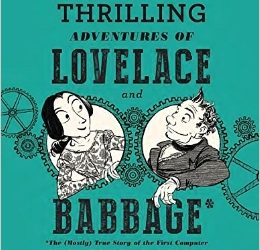Editor’s Note: Continuing an annual tradition, we take a moment to pause at year’s end to look back on the best books we encountered. As always, this is not a “best books of 2016″ list, but a list of the best books the Chefs read during 2016 — the books might be classics, a few years old, or brand new. This is one of the great things about books in all forms — they endure, invite visitation and revisitation, and beckon with ideas. Here’s Part 2 of our list, Part 1 is available here.
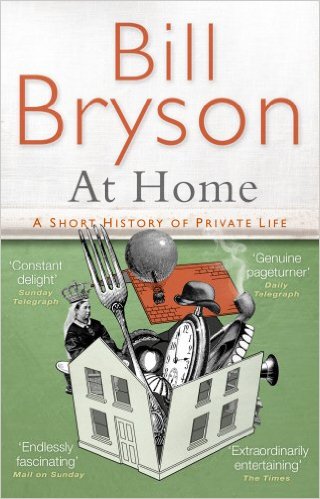 Charlie Rapple: This year, I nominate one book that I knew I would include in this list as soon as I read it — and another that didn’t immediately strike me that way, but has stayed with me so much that it feels worthy of mention. The no-brainer is Bill Bryson’s At Home — by no means his latest, but one I’ve only just caught up with. Billed as “a history of private life”, one might expect it to be on the dry side. But no. It is a fabric of fabulous factoids, skilfully woven together with narrative, pace, drama and suspense. Although structured around the rooms in Bryson’s own home, his story takes us around the world (where have the plants in our garden come from, what do notches in log cabins tell us about the provenance and movements of American pioneers? etc). Having read the book early this year, I’ve since quoted many of its facts liberally and likely inaccurately (did you know that, after cars, stairs cause more deaths than anything else? that Britain used to import all its ice from one small lake in Massachusetts? that Thomas Edison once tried to launch a range of concrete furniture, including a concrete piano?) Imagining how many sources underpin this book makes one feel faint — from the history of why we have small rows of pointless buttons on our cuffs, to the quantities of people poisoned by William Morris wallpaper, or the fact that houses didn’t used to have doors and were entered by crawling over the roof, this book is an impressive summary of a huge range of research, and for me, its the epitome of finding the story behind the science in order to bring research to life.
Charlie Rapple: This year, I nominate one book that I knew I would include in this list as soon as I read it — and another that didn’t immediately strike me that way, but has stayed with me so much that it feels worthy of mention. The no-brainer is Bill Bryson’s At Home — by no means his latest, but one I’ve only just caught up with. Billed as “a history of private life”, one might expect it to be on the dry side. But no. It is a fabric of fabulous factoids, skilfully woven together with narrative, pace, drama and suspense. Although structured around the rooms in Bryson’s own home, his story takes us around the world (where have the plants in our garden come from, what do notches in log cabins tell us about the provenance and movements of American pioneers? etc). Having read the book early this year, I’ve since quoted many of its facts liberally and likely inaccurately (did you know that, after cars, stairs cause more deaths than anything else? that Britain used to import all its ice from one small lake in Massachusetts? that Thomas Edison once tried to launch a range of concrete furniture, including a concrete piano?) Imagining how many sources underpin this book makes one feel faint — from the history of why we have small rows of pointless buttons on our cuffs, to the quantities of people poisoned by William Morris wallpaper, or the fact that houses didn’t used to have doors and were entered by crawling over the roof, this book is an impressive summary of a huge range of research, and for me, its the epitome of finding the story behind the science in order to bring research to life.
 Now on to Austin Tappan Wright’s Islandia. I bought this book by accident, expecting it to be a travelogue about Iceland. (Seriously). Instead I found myself reading the secret writings of a law professor who spent his free time creating and losing himself in an imaginary world that is cut off from the “civilization” of the early twentieth-century western world. This is another book of detail: I suppose a bit like Tolkien (but without the fantasy feel), he’s mapped out the geography, created a language and a political hierarchy, figured out transport and agricultural practices and domestic routines (Islandia is a land without combustion engines or electricity), and invented customs and sports (I remember in particular the exhaustive description of the unusual skis worn in Islandia). Within all of this are love stories, power struggles, battles, even import–export sagas. It is the most unique book I have ever read in terms of the breathtaking depth of the author’s imaginings, and despite the slowness of plot (if you could even describe it as having such a thing), it is utterly enticing, I think perhaps because of its escapism. I slept soundly after each visit to Islandia and was surprised to find myself quite sad to finish it.
Now on to Austin Tappan Wright’s Islandia. I bought this book by accident, expecting it to be a travelogue about Iceland. (Seriously). Instead I found myself reading the secret writings of a law professor who spent his free time creating and losing himself in an imaginary world that is cut off from the “civilization” of the early twentieth-century western world. This is another book of detail: I suppose a bit like Tolkien (but without the fantasy feel), he’s mapped out the geography, created a language and a political hierarchy, figured out transport and agricultural practices and domestic routines (Islandia is a land without combustion engines or electricity), and invented customs and sports (I remember in particular the exhaustive description of the unusual skis worn in Islandia). Within all of this are love stories, power struggles, battles, even import–export sagas. It is the most unique book I have ever read in terms of the breathtaking depth of the author’s imaginings, and despite the slowness of plot (if you could even describe it as having such a thing), it is utterly enticing, I think perhaps because of its escapism. I slept soundly after each visit to Islandia and was surprised to find myself quite sad to finish it.
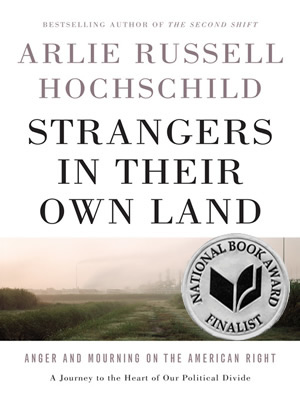 Alison Mudditt: It’s hard for me not to think about the “best” book of 2016 in light of the presidential election, and so by far the most powerful and important book I have read this year is Arlie Hochschild’s Strangers in their Own Land: Anger and Mourning on the American Right . Like many an angst-ridden coastal elite, I’ve been struggling to understand so much of what the 2016 campaign laid bare and feeling repelled by much of it. But from all my years as a psychology editor (and being married to a social psychologist!), I know all about the Contact Hypothesis and so I’ve been trying to broaden my own understanding.
Alison Mudditt: It’s hard for me not to think about the “best” book of 2016 in light of the presidential election, and so by far the most powerful and important book I have read this year is Arlie Hochschild’s Strangers in their Own Land: Anger and Mourning on the American Right . Like many an angst-ridden coastal elite, I’ve been struggling to understand so much of what the 2016 campaign laid bare and feeling repelled by much of it. But from all my years as a psychology editor (and being married to a social psychologist!), I know all about the Contact Hypothesis and so I’ve been trying to broaden my own understanding.
There are of course a number of books out there (I’d also recommend Hillbilly Elegy by J.D.Vance), but Arlie is a long-term UC Press author and knowing her work and her incredible listening ability, I gravitated towards this book. Known for her pioneering work over the years as a feminist sociologist, here she takes her sociological toolkit on a journey into deep red bayou country – an area plagued by environmental degradation, poverty and ill health. For both Hochschild and myself, this is a totally unknown world and one that is well outside of our liberal bay area comfort zone. Above all, what impressed me is her ability to empathize with the people she meets – she avoids the obvious stereotypes and portrays each one with dignity and compassion. Her journey reveals rich characters defined by traditional family, Christianity and “white culture”, straining to align difficult lives with their strong political beliefs.
As someone who struggles to understand why such people vote for individuals and a party that seems to be against their self-interest, this book has helped me begin to understand this complicated paradox. There are plenty of data and facts for the more academic reader, but also a strong emotional thread that connects the stories and the reader to the pipefitters, truck drivers, plant operators, and others at the heart of Hochschild’s story. Highly recommended for all liberals looking to burst out of their personal filter bubbles.
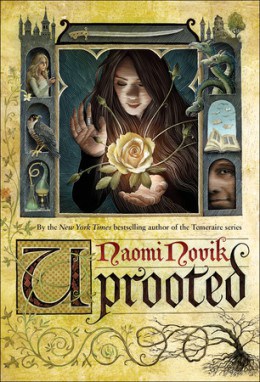 David Crotty: As a father and the spouse of an educator, I have come to greatly appreciate the importance and power of fairy tales. Fairy tales are a clear expression of our common humanity. The basic archetypes used by the human brain to interpret the world are expressed through each culture’s folk tales, which all seem to tell variations on the same stories. Because of this, they serve as important educational tools, a means for anyone to understand and come to grips with reality as we humans experience it. Perhaps most important is the lesson that fairy tales teach us, as author G.K. Chesterton (here paraphrased by Terry Pratchett) tells us:
David Crotty: As a father and the spouse of an educator, I have come to greatly appreciate the importance and power of fairy tales. Fairy tales are a clear expression of our common humanity. The basic archetypes used by the human brain to interpret the world are expressed through each culture’s folk tales, which all seem to tell variations on the same stories. Because of this, they serve as important educational tools, a means for anyone to understand and come to grips with reality as we humans experience it. Perhaps most important is the lesson that fairy tales teach us, as author G.K. Chesterton (here paraphrased by Terry Pratchett) tells us:
One of the great popular novelists of the early part of this century was G.K. Chesterton. Writing at a time when fairy tales were under attack for pretty much the same reason as books can now be covertly banned in some schools because they have the word ‘witch’ in the title, he said: “The objection to fairy stories is that they tell children there are dragons. But children have always known there are dragons. Fairy stories tell children that dragons can be killed.”
Which brings me to my favorite book read in the past year, Naomi Novik’s Uprooted. Uprooted is in every sense a fairy tale, the story of a young girl whisked away to the tower of a dark wizard who turns out to be more than he seems. While it is a book for adults, not children, it incorporates much of what we think of as the tradition of fairy tales. It’s beautifully written, in a straightforward and compelling style, and as Novik notes in her own biography, clearly influenced by both J.R.R. Tolkien and the Polish folk tales she grew up on. Novik is perhaps best known for her Temeraire series, essentially a Jane Austen-ish retelling of the Napoleonic Wars, but with dragons. Over the years (the series began in 2006 and just ended this year), one can see a growth in Novik’s writing, as she finally becomes a master of pacing around the seventh Temeraire novel. That mastery is on full display in Uprooted, which is one of the most intense books I’ve read in a long time. It hurtles along at breakneck pace and is the sort of book where you will find yourself looking up at the clock and realizing that it is way past your normal bedtime, but you really need to know what happens next, so maybe just one more chapter…
Like most fairy tales, Uprooted is both dark and hopeful, and carries with it a message of empowerment. It is the well-deserved winner of the 2016 Nebula Award for Best Novel, the 2016 Locus Award for Best Fantasy Novel, the 2016 British Fantasy Society Award for Best Novel, and was shortlisted for the 2016 World Fantasy Award for Best Novel and the 2016 Hugo Award for Best Novel, and I strongly recommend it.
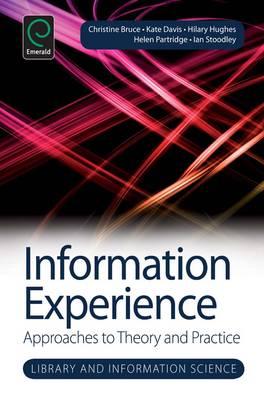 Lettie Conrad: I cannot, in good conscience, recommend this as a cozy-up-to-the-fireplace sort of book, but it stands out as one that has changed my life, my career, and my way of thinking about how humans interact with information and the products that deliver it. Information Experience: New Approaches to Theory and Practice is a collection of articles that define an emerging framework for understanding the lived human experience with and relationship to information. From the fields of education to psychology to interaction design, multidisciplinary research analysis comes together to encourage us to think beyond the confines of the measurable, behavioral aspects of our information lives. Our information experience must encapsulate the cultural, emotional, and other nuanced factors that influence the social construction of information and its meanings. As both a research subject and analytical device, information experience enhances research analysis across diverse scholarly perspectives, from the abstract to the practical. The editors of this book, largely information scientists at Queensland University of Technology, invite readers to contribute to this evolving framework and explore new ways of measuring and understanding the human information experience.
Lettie Conrad: I cannot, in good conscience, recommend this as a cozy-up-to-the-fireplace sort of book, but it stands out as one that has changed my life, my career, and my way of thinking about how humans interact with information and the products that deliver it. Information Experience: New Approaches to Theory and Practice is a collection of articles that define an emerging framework for understanding the lived human experience with and relationship to information. From the fields of education to psychology to interaction design, multidisciplinary research analysis comes together to encourage us to think beyond the confines of the measurable, behavioral aspects of our information lives. Our information experience must encapsulate the cultural, emotional, and other nuanced factors that influence the social construction of information and its meanings. As both a research subject and analytical device, information experience enhances research analysis across diverse scholarly perspectives, from the abstract to the practical. The editors of this book, largely information scientists at Queensland University of Technology, invite readers to contribute to this evolving framework and explore new ways of measuring and understanding the human information experience.
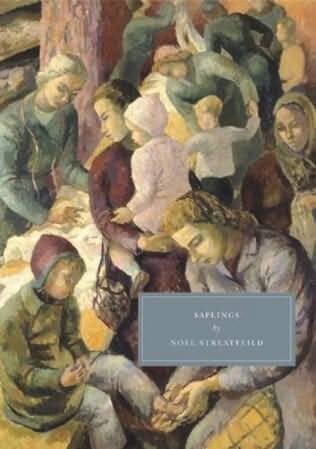 Alice Meadows: Saplings, by Noel Streatfield, has at its heart the critical importance — for all of us, but especially for children — of knowing that we are loved. And the grim consequences when that love is unexpectedly taken from us. I realize it may not sound like the most uplifting of tales — it’s not! — but nevertheless I highly recommend it. Streatfield had an uncanny ability to see life from a child’s perspective, making her a hugely popular children’s author. Saplings (originally published in 1945) is a very well-observed, if increasingly grim and depressing, story of a typical upper middle-class English family from just before the outbreak of World War II until its end. It charts the transformation of the Wiltshire family from happy pre-war times to a broken and dysfunctional post-war future. Writing from the viewpoint of the four Wiltshire children, Laurel, Tony, Kim, and Tuesday — the saplings of the title — Streatfield shows how a combination of bad luck, benign (and not-so benign) neglect, and complacency on the part of the adults in their lives ultimately have devastating consequences for the children in their care. As the oldest child Laurel puts it: “Really! I wish I didn’t have to grow up… I’m beginning to wonder if we’ve not been told things wrong. I mean, we’re told that children behave badly and grown ups are always right. I wonder if we shan’t find that grown-ups do worse things than children.” While some of the language and attitudes in Saplings may be old-fashioned, that message feels all too relevant to me in today’s topsy-turvy world.
Alice Meadows: Saplings, by Noel Streatfield, has at its heart the critical importance — for all of us, but especially for children — of knowing that we are loved. And the grim consequences when that love is unexpectedly taken from us. I realize it may not sound like the most uplifting of tales — it’s not! — but nevertheless I highly recommend it. Streatfield had an uncanny ability to see life from a child’s perspective, making her a hugely popular children’s author. Saplings (originally published in 1945) is a very well-observed, if increasingly grim and depressing, story of a typical upper middle-class English family from just before the outbreak of World War II until its end. It charts the transformation of the Wiltshire family from happy pre-war times to a broken and dysfunctional post-war future. Writing from the viewpoint of the four Wiltshire children, Laurel, Tony, Kim, and Tuesday — the saplings of the title — Streatfield shows how a combination of bad luck, benign (and not-so benign) neglect, and complacency on the part of the adults in their lives ultimately have devastating consequences for the children in their care. As the oldest child Laurel puts it: “Really! I wish I didn’t have to grow up… I’m beginning to wonder if we’ve not been told things wrong. I mean, we’re told that children behave badly and grown ups are always right. I wonder if we shan’t find that grown-ups do worse things than children.” While some of the language and attitudes in Saplings may be old-fashioned, that message feels all too relevant to me in today’s topsy-turvy world.
 Michael Clarke: I typically read at least two books concurrently and usually fill one slot with a fiction title and one with non-fiction. Earlier this year I selected Seveneves by Neal Stephenson as my fiction pick and Sapiens: A Brief History of Humankind by Yuval Harari as my non-fiction pick. The pairing was largely happenstance – they both were 2015 books percolating up to the top of my “to read” stack. Based on a cursory review the books look to have very little to do with each other, but as I read deeper they formed a serendipitous pairing.
Michael Clarke: I typically read at least two books concurrently and usually fill one slot with a fiction title and one with non-fiction. Earlier this year I selected Seveneves by Neal Stephenson as my fiction pick and Sapiens: A Brief History of Humankind by Yuval Harari as my non-fiction pick. The pairing was largely happenstance – they both were 2015 books percolating up to the top of my “to read” stack. Based on a cursory review the books look to have very little to do with each other, but as I read deeper they formed a serendipitous pairing.
Sapiens is a nonfiction dive into the deep history of the human species – including the period when there were other species of humans living next to us. Sapiens first came to my attention via the review by Bill Gates and subsequently by the Scholarly Kitchen’s own Kent Anderson. The book describes the major milestones of our species and speculates that something called the Cognitive Revolution occurred around 70 thousand years ago that allowed Homo sapiens to think abstractly and to communicate abstract ideas. Most importantly, according to Harari, we developed the ability to share collective fictions: myth, religions, political structures, and ultimately concepts like money, justice, and limited liability companies. These collective fictions allow Homo sapiens to organize ourselves in societies that exceed the size of a small tribe. Harari goes on to describe how this ability has played out for better and worse across the eons. While the book has its quirks (Harari is not a fan of agriculture), it is nonetheless a welcome “big picture” view. It is a worthwhile read if for no other reason than to invite the reader to go beyond the typical history (which usually spans at most a few human lifespans) and meditate on the long sweep of human history and pre-history over the last 100,000 years.
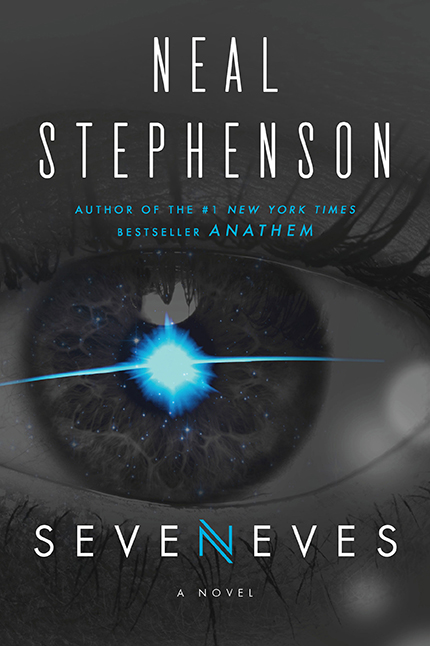 Where Sapiens is a reflection on our past and how we got here, Seveneves is a dark meditation on our future. It ranks among the most haunting books I have ever read. It is one of those books that is both difficult to put down and that lingered in my thoughts since finishing it. Set in the near future, Seveneves begins with a mysterious event (called “the Agent”) that causes the moon to shatter into seven pieces. As scientists study the event, the future implications become all too clear. The large pieces will, due to their gravitational attractions to each other, collide and become smaller pieces. This will keep happening until the pieces are so small they drop out of orbit. When they drop out of orbit they will fall to earth with such devastating consequences that the surface of the planet will become utterly uninhabitable for thousands of years. What follows is a mad rush to launch as many people and materials into orbit as possible with the entire industrial output of the world reorganized to this goal. The first half of the book is chronicle of the human, political, and technical obstacles involved – with particular attention to detail on the latter (Neal Stephenson spent some time working at Blue Origin, Jeff Bezo’s rocket company, which shows). It is frantic and harrowing. The second half of the book deals with the long-term implications (to the human species, our civilization, and the planet) of the events of the book’s first half. I will leave it at that to avoid spoilers except to say that it picks up many of the themes and ideas in Sapiens. I have long been a fan of Neal Stephenson’s work and this ranks among his best. This one made Gates’ list as well.
Where Sapiens is a reflection on our past and how we got here, Seveneves is a dark meditation on our future. It ranks among the most haunting books I have ever read. It is one of those books that is both difficult to put down and that lingered in my thoughts since finishing it. Set in the near future, Seveneves begins with a mysterious event (called “the Agent”) that causes the moon to shatter into seven pieces. As scientists study the event, the future implications become all too clear. The large pieces will, due to their gravitational attractions to each other, collide and become smaller pieces. This will keep happening until the pieces are so small they drop out of orbit. When they drop out of orbit they will fall to earth with such devastating consequences that the surface of the planet will become utterly uninhabitable for thousands of years. What follows is a mad rush to launch as many people and materials into orbit as possible with the entire industrial output of the world reorganized to this goal. The first half of the book is chronicle of the human, political, and technical obstacles involved – with particular attention to detail on the latter (Neal Stephenson spent some time working at Blue Origin, Jeff Bezo’s rocket company, which shows). It is frantic and harrowing. The second half of the book deals with the long-term implications (to the human species, our civilization, and the planet) of the events of the book’s first half. I will leave it at that to avoid spoilers except to say that it picks up many of the themes and ideas in Sapiens. I have long been a fan of Neal Stephenson’s work and this ranks among his best. This one made Gates’ list as well.
Discussion
6 Thoughts on "Chefs’ Selections: The Best Books Read During 2016 Part 2"
I found the pacing of Uprooted to be quite poor and couldn’t wrap my head around the amount of praise it garnered. It’s a fine read, sure, but seemed in an awkward zone between teen lit and “edgy” fantasy (which may explain why it was so popular).
On another note, I like these “off-topic” posts, but it’d be a cool concept if you all did a University Press version–UPs have such interesting titles that don’t often get visibility out of their specific fields, so it would be great if the chefs brought some of them to light (as Alison kind of did).
Ooh, I love that idea. One of my other favourite reads this year, that almost made my final cut, was a University of California Press title, Arctic Labyrinth (Glyn Williams). On a related note, I still encourage people to read the American Society of Civil Engineering’s books, Circles in the Sky (Rich Weingardt), which I first read about 8 years ago – it is the fascinating story of George Ferris (inventor of the wheel), and I cannot believe it has not yet been made into a film – his life was a classic rise-and-fall, battle against the odds to achieve great things but then lose it all, kind of story, just made for the screen.
I love the UP idea, although with my OUP employee discount, I suspect my entry might constitute a conflict of interest.
As for the pacing, I think I appreciated that she put into one book what many authors would have stretched out to a trilogy. I really liked the relentless pace and feeling exhausted after every chapter.
This feature is a treat to read and comes at such a good time of the year–just when I’m contemplating gifts and having a few more holidays to read myself. I third the university press idea and I immediately thought about books out of my field (and not in the books program I oversee) that I’ve learned so much from and would love thinking/ writing about here. Also just put _Artic Labyrinth_ on my list…
My Princeton senior thesis advisor for whom I later served as editor of his book Philosophy and the Mirror of Nature (Princeton, 1979) that catapulted him into the ranks of public intellectuals, Richard Rorty, predicted the Trump phenomenon back in 1998 in his Harvard book Achieving Our Country, as revealed in this NY Times story yesterday: http://www.nytimes.com/2016/11/21/books/richard-rortys-1998-book-suggested-election-2016-was-coming.html?_r=0 Might want to put this on your list also, Alison.



